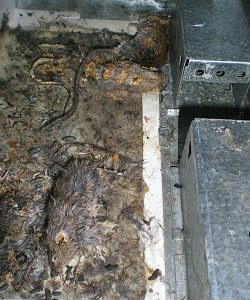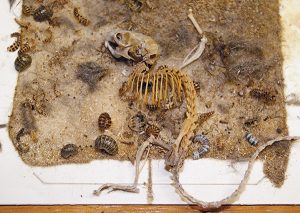
Photos: Mark Sheperdigian
The photo here is a grisly image, but it shows what can happen when we lose track of our traps. Although these mice are no longer active, they now constitute conditions conducive to other pests. The obvious pest would be blow flies (Calliphoridae) and indeed, you can see a few fly larvae that emerged from the bodies left in this trap.
The flies will be short-lived because the mouse carcasses are small and dry out quickly, but what will be next? There are a number of other pests that will finish the job the flies left undone. A number of pests will colonize the dried carcasses, including spider beetles (Ptinidae) and clothes moths (Tineidae), but the most common pests will be dermestid beetles. The family name Dermestidae refers to their habit of feeding on dry skin, hair and nails. Among the dermestids infesting mouse carcasses are hide beetles (Dermestes maculatus), larder beetles (D. lardarius), warehouse beetles (Trogoderma spp.) and carpet beetles (Attagenus spp. and Anthrenus spp.).
 The photo here shows the cast skins of larder beetles that cleaned the carcass to the bone. By then, the glueboard had lost all of its tackiness and the beetles developed in peace.
The photo here shows the cast skins of larder beetles that cleaned the carcass to the bone. By then, the glueboard had lost all of its tackiness and the beetles developed in peace.
Beyond the carcass, dermestids can develop on any aspect of a rodent infestation — including rodent nests and even rodenticide set out for control.
Contributor Mark Sheperdigian, BCE, can be reached at sheperdigian@earthlink.net.
Leave A Comment